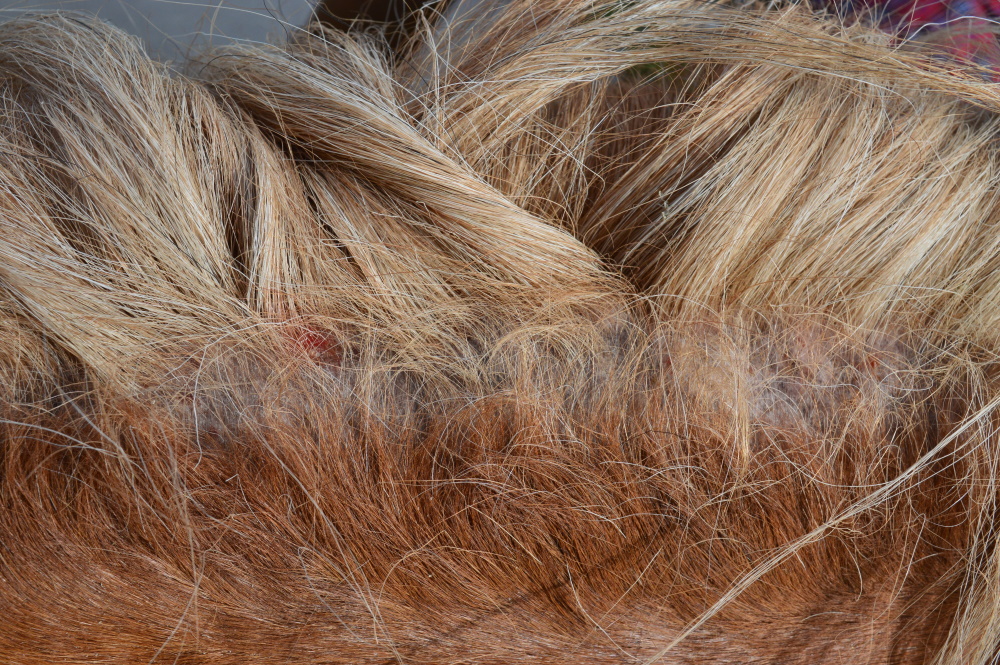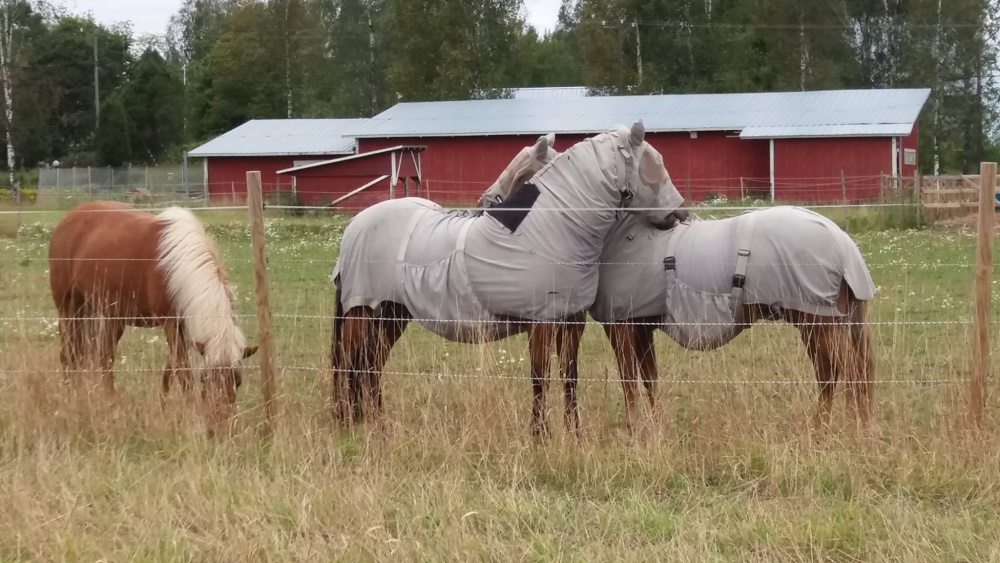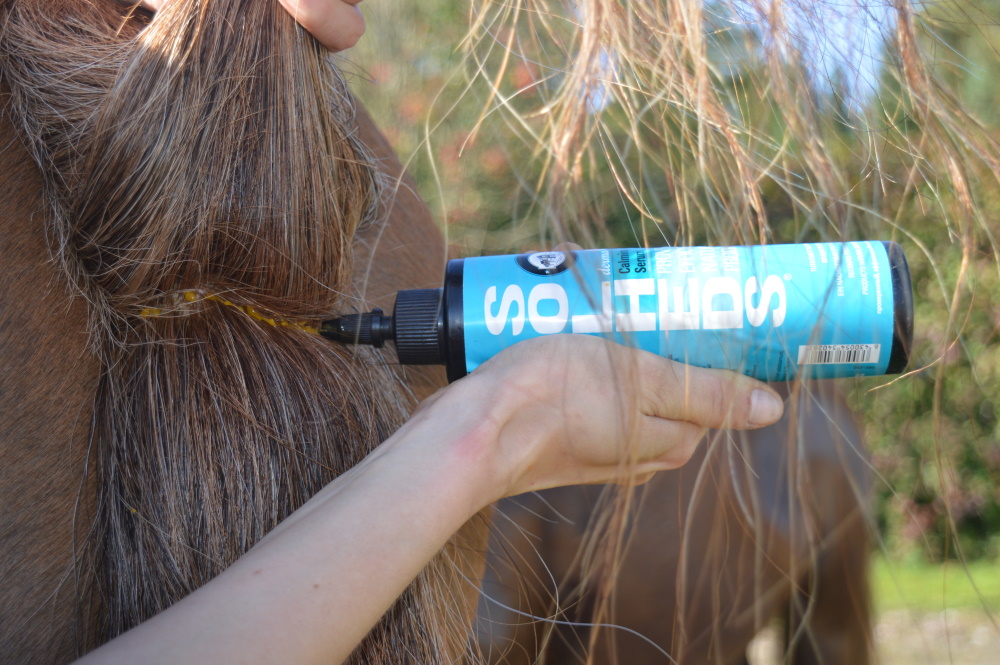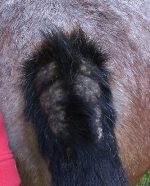Allergic Reaction Caused by Insect Bites
While summer is a wonderful time, it is also the peak season for skin problems in horses. Nearly all horses have an allergic reaction on insect bites.
Symptoms
Usually, the reaction manifests as itching, typically in the tail or mane area. It’s important to understand that as long as the animal is exposed to what it’s allergic to, it will continue to have symptoms. When the symptoms increase and the horse regularly rubs itself, it can be considered to have summer eczema. Insects, especially Culicoides midges, cause allergic reactions. They cannot be entirely avoided, but insect exposure can be reduced.
Summer eczema is often experienced as a challenging condition. Unfortunately, sometimes the disease is failed to be recognized as summer eczema. It’s difficult to accept that a horse has a chronic skin disease requiring regular lifelong treatment. A horse that is itching and symptomatic can even be perceived as “embarrassing,” a weak individual in active use.

Target with local treatment
Horses suffering from insect itching and even summer eczema can be helped with good localized treatment. The goal of the treatment is to:
- Relieve symptoms and make the horse more comfortable.
- Improve the skin’s resistance and resilience to insect bites and external mechanical rubbing.
- Avoid complications/additional diseases. Allergic skin, due to rubbing, is susceptible to other skin problems (skin infections, wounds), especially if the symptomatic skin is left untreated.
Treating allergic reactions and itching caused by insect bites requires comprehensive treatment to achieve the best treatment outcome. It’s important to start treatment early. Especially for horses with summer eczema, it’s not advisable to wait for symptoms to appear but to strengthen the skin preventively with good localized treatment.
Avoid the allergy causing agents
Modify the conditions to keep pastures, the environment, and the stable as insect-free as possible. An open, windy area without stagnant water (ponds, water in ditches) is the best pasture. Culicoides midges don’t fly in darkness. Keep the stable dark in the evenings and early mornings; Culicoides midges are most active during these times. A dark stable at night can be a good option for some horses. Insect and eczema rugs provide significant relief for many horses.
A rug reduces the insect load and provides mechanical protection when the horse rubs itself. The rug wears out first when the horse rubs. Multiple eczema rugs are needed: one on the horse, one in wash, and one under repair.
Insect repellents and insecticides. Insects primarily prey using their sense of smell, detecting the carbon dioxide secreted by animals. Horseflies also prey by sensing the animal’s warm temperature. Therefore, it’s more challenging to control horseflies, and horseflies pose a greater problem for dark-colored horses whose hair/skin heats up more in the sun.

EU legislation on biocidal products requires all active substances and products to be registered. Commercially, this process is not practical and feasible for natural substances. Only very few natural substances are registered as biocidal products.
Unregistered natural products cannot be marketed as insect repellents, but the sale of these products is not prohibited by EU biocide legislation as long as these products are not marketed as insecticides.
Sensitive horses are often hypersensitive to officially approved insecticides, whose active ingredients are mainly neurotoxins, such as permethrin. There are many different insecticides and repellents on the market; try what suits your horse best.
If you decide to make your own repellent mixture, test it on your own skin in sunlight before exposing your horse’s sensitive skin to your own “cooking” in a 24/7 situation in full sunlight.
Skin Care
Another cornerstone in the treatment of insect itching is hygiene and maintaining the skin’s moisture balance. Generally, washing with water is sufficient. If the itching is severe and the skin is broken, there is a risk of infection. In this case, an antiseptic wash is needed to reduce microbial load and wash away possible pathogens. Many antiseptic shampoos are effective but often too harsh for sensitive skin. Choose a skin-friendly shampoo to prevent further drying and irritation of the already dry problem skin. Avoid sulphate-based shampoos.
Dry skin should be moisturized to keep it flexible and elastic, thus more resistant to rubbing. As the season progresses, it’s advisable to treat horses with summer eczema daily. Seek help and establish a care network if you cannot regularly visit the stable to care for your horse yourself.
Avoid thick ointments, paraffin/vaseline products, and pure oil products. They are poorly absorbed by the skin and collect dirt. This, in turn, increases the risk of infection for rubbed skin.
A good rule of thumb is that anything you wouldn’t put on your own skin shouldn’t be applied, especially to a horse’s damaged skin.
Often, treatment focuses solely on the areas of hair loss. Treat the entire mane and tail, not just the areas where the horse has rubbed its hair. Ears are another challenging area to treat and easily go unnoticed. Symptoms in the armpits and legs can often surprise.
It’s important to feel the skin to detect early when the skin condition deteriorates. When the skin temperature rises and elasticity decreases, the skin becomes harder and means that skin requires treatment.


Treating Allergic Inflammatory Reactions
Allergic inflammatory reactions causing itching require treatment. The most effective anti-inflammatory drug currently on the market for reducing allergic inflammatory reactions is cortisone. Cortisone use should always be done in collaboration with a veterinarian. Cortisone use is associated with serious side effects, e.g., laminitis, especially in native breeds (Finnhorse, shetlands pony…).
Some natural substances also have an anti- inflammatory effect. Therefore, natural products can also be helpful, especially if treatment is started early. In acute situations where the horse has rubbed itself to wounds, a veterinarian should be called. The veterinarian assesses what treatment the horse needs and whether cortisone treatment is necessary.

Horsefly Bites
Different insects cause different types of damage to the skin. Some of them bite holes into the skin. Usually, these are horseflies. Typically, they bite the chest and neck. Open bite wounds carry a risk of infection. The recommended treatment is antiseptic washing and applying an antimicrobial cream/wound oil to dry skin. Note that horseflies prey by sensing heat, which makes protecting horses against horseflies more challenging. Therefore, it’s good to provide shaded areas in the pasture to keep horses cooler.

Animal Care Products
When choosing care products, especially for sensitive skin and treating damaged skin, caution must be exercised. Safe and effective animal care products are not a given on the market.
According to regulations, animal care products are technical preparations; legally, animals are objects. The product safety required by authorities for animal products is the same as, for example, house paint or car products. Products may contain ingredients that are harmful to animals and completely unsuitable for animal care products. The manufacturer determines their own quality and product safety level, not the authorities. Animals are not protected by law as humans are through cosmetics legislation (shampoos, skin care products, etc.).
Avoid products without ingredient lists and those containing chemical hazard warnings (corrosive, flammable, etc.). Choose products where you can verify the manufacturer’s competence in the field, not just mentioned anonymous experts and influencers’ praise. A well-known brand or natural product is not a guarantee of product safety.
Read more on product safety here.

Prevention
The belly, udders, are areas particularly prone to insect attacks. Here, the skin is thinner and there’s no hair to protect it. Check these areas daily and treat as needed. Simply washing with a moisturising antiseptic shampoo and applying soothing and healing cream once a week can prevent major skin problems preventively. Reduce insect exposure by using appropriate insect repellents. Please note that the insect repellants should be placed under the rug, not on top.
Eyes are also susceptible to insect attacks. Keep the area around the eyes clean. Towards the end of summer, skin problems caused by insects increase. Start treatment early to avoid bigger problems. The skin is the horse’s largest organ and deserves good care.
SOLHEDS Derma products are proven effective natural products. Only pure and analyzed raw materials are used in the products. The products are developed to support the skin’s physiological function. Due to their plain chemistry, SOLHEDS Derma products are suitable for sensitive skin; chemical load on the skin is minimized. Thus, the products are also suitable for foals and lactating mares.
SOLHEDS Derma products do not contain substances prohibited by FEI regulations.
SOLHEDS, when your horse deserves safe and effective treatment.
On our website www.solheds.com, you can find instructions for caring for your horse’s skin, skin problems, hooves, and hair in a skin-friendly way.
SOLHEDS products are pioneers in animal product safety and pioneers in local treatment of horses’ summer eczema.


Author: Biochemist Saija Pihkanen
Graduated with a Master of Science from the University of Helsinki
Work experience: Researcher at the Veterinary School, Acting Senior Lecturer in Biochemistry.
Over 20 years of international leadership positions in the pharmaceutical and biotech industries. Professional in drug development.
Developer of the SOLHEDS product line.
Clinical study of summer eczema in horses, Veterinary Days 2015, Helsinki.
Guidelines for caretakers of horses with summer eczema based on research.
The SOLHEDS product line was originally developed for the treatment of the author’s own horse’s summer eczema and dog’s hotspots, as well as the author’s own skin problems.
Studied summer eczema in horses for over 20 years and treated over 200 horses with summer eczema.
Suomenratsut ry awarded Saija the Horse Welfare Award in 2018.


